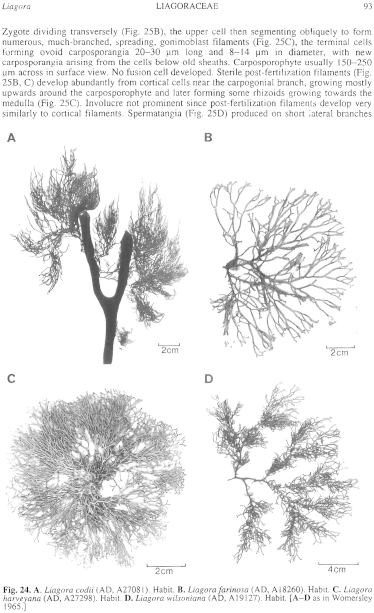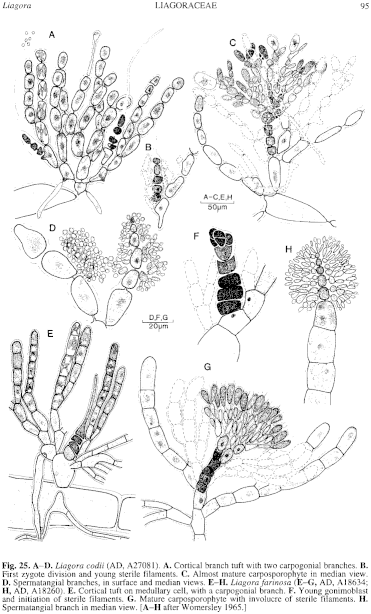|
|
|
|
|
|||||||||||
|
Electronic Flora of South Australia Species Fact Sheet
Phylum Rhodophyta – Class Florideophyceae – Order Nemaliales – Family Liagoraceae
Selected citations: Boergesen 1927: 59, figs 32, 33. Levring 1953: 504. Umezaki 1961: 233, figs 1, 2. Yamada 1938: 23, figs 15, 16. Womersley 1965: 478, figs 59–62, pl. 6 fig. 2.
Synonyms
L. cheyniana Harvey 1855a: 552; 1860b, pl. 162; 1863, synop.: xxxviii. J. Agardh 1876: 515. Kützing 1858: 44, pl. 92. Lucas & Perrin 1947: 134.
L. cliftoni (Harvey) J. Agardh 1876: 515. Lucas & Perrin 1947: 134.
Galaxaura cliftoni Harvey 1863: pl. 275, synop.: xxxviii (excluding Warrnambool specimen = L. codii).
Thallus (gametophyte)(Fig. 24B) brownish red, moderately calcified, 5–15 cm high, terete, subdichotomously branched every 0.5–2 cm with occasional lateral branches; lower thallus 1–1.5 (–2) mm in diameter, tapering slightly to apices. Holdfast discoid, 1–3 (–5) mm across; epilithic or epiphytic on larger brown algae. Structure of a medulla of large, elongate cells (Fig. 25E) 50–150 µm in diameter, mixed with slender rhizoids in older parts, and a cortex 350–450 µm broad, of branch tufts of filaments consisting of a basal cell (Fig. 25E), cut off from a medullary cell, which produces several straight to slightly curved cortical filaments, branched near the base 1–4 times, 15–20 1.n in diameter, cells LID 2–3, not or only very slightly constricted at their cross walls (Fig. 25E), rhodoplasts irregularly stellate, each with a central pyrenoid. Basal cells of cortical branch tufts producing slender rhizoids which grow over and between the medullary cells.
Tetrasporophyte minute, filamentous, branched (Stosch 1965).
Reproduction: Sexual thalli dioecious. Carpogonial branches (Fig. 25E) borne on the basal to third cell of the cortical branch tufts, almost straight, of 4 cells with a conical carpogonium. Zygote dividing transversely (Fig. 25F), the upper cell segmenting obliquely to produce a dense compact carposporophyte (Fig. 25G) 120–200 µm across in surface view, of relatively few cells, the end cells developing into ovoid-clavate carposporangia (Fig. 25G) 16–25 µm long and 8–11 µm in diameter; new carposporangia proliferating from cells below sheaths of previous ones. No fusion cell developed. Sterile post-fertilization filaments develop from cortical cells (Fig. 25F, G) adjacent to the carpogonium, and form a slight and loose involucre around the carposporophyte, consisting of filaments similar to the cortical filaments (Fig. 25G). Spermatangia (Fig. 25H) produced at apex of cortical filaments, from a globose-ovoid head 40–70 1.1m across, consisting of a central row of 4–6 cells cutting off 2–3 orders of cells, the ultimate elongate spermatangial initials cutting off ovoid spermatangia 2–4 µm in diameter.
Tetrasporophyte with irregularly divided tetrasporangia and monosporangia.
Type from the Red Sea, near Suez; in CN.
Selected specimens: Cowaramup Bay, W. Aust. (Norris 1976, 17.iii.1959; AD, A26314). Near Coffin I., Albany, W. Aust., 1 m deep (Huisman, 4.iv.1993; Murdoch). Cape Riche, W. Aust. (Harvey, Alg. Aust. Exsicc. 352; AD, A18260). Barker Rocks, Yorke Pen., S. Aust., on Cystophora spp., upper sublittoral (Womersley, 25.iii.1967; AD, A31378 -"Marine Algae of southern Australia" No. 73, originally distributed in error as L. codii). Marino, S. Aust., drift (Womersley, 21.v.1953; AD, A18634). Port Noarlunga, S. Aust., 6 m deep inside reef (Kraft, 15.iii.1973, AD, A43048).
Distribution: Tropical and subtropical seas, extending into warm temperate regions. Isolated shallow (and warmer) bays around southern Australia from Cowaramup Bay (and further north), W. Aust., to Port Noarlunga, S. Aust.
Taxonomic notes: Liagora preissii Kützing 1858: 45, pl. 93e-k, from W. Aust. (Preiss, type in MEL, 8587), is probably a synonym of L. farinosa.
References:
AGARDH, J.G. (1876). Species Genera et Ordines Algarum. Vol. 3, Part 1 - Epicrisis systematis Floridearum, pp. i-vii, 1–724. (Weigel: Leipzig.)
BOERGESEN, F. (1927). Marine algae from the Canary Islands, especially from Teneriffe and Gran Canaria. III. Rhodophyceae. Part I. Bangiales and Némalionales. K. danske Vidensk. Selsk. Biol. Meddr 6(6), 1–97.
HARVEY, W.H. (1855a). Some account of the marine botany of the colony of Western Australia. Trans. R. Ir. Acad. 22, 525–566.
HARVEY, W.H. (1860b). Phycologia Australica. Vol. 3, Plates 121–180. (Reeve: London.)
HARVEY, W.H. (1863). Phycologia Australica. Vol. 5, Plates 241–300, synop., pp. i-lxxiii. (Reeve: London.)
KÜTZING, F.T. (1858). Tabulae Phycologicae. Vol. 8. (Nordhausen.)
LAMOUROUX, J.V.F. (1816). Histoire des Polypiers Coralligènes Flexibles. (Poisson: Caen.)
LEVRING, T. (1953). The marine algae of Australia. I. Rhodophyta: Goniotrichales, Bangiales and Némalionales. Arkiv för Bot. Ser. 2, 2, 457–530.
LUCAS, A.H.S. & PERRIN, F. (1947). The Seaweeds of South Australia. Part 2. The Red Seaweeds. (Govt Printer: Adelaide.)
STOSCH, H.A. VON (1965). The sporophyte of Liagora farinosa Lamour. Br. phycol. Bull. 2, 486–496.
UMEZAKI, I. (1961). A developmental study of reproductive organs of Liagora farinosa Lamx. J. Jap. Bot. 36, 233–239.
WOMERSLEY, H.B.S. (1965). The Helminthocladiaceae (Rhodophyta) of southern Australia. Aust. J. Bot. 13, 451–487, Plates 1–7.
YAMADA, Y. (1938). The species of Liagora from Japan. Sci. Pap. Inst. Algol. Res. Hokkaido Univ. 2, 1–34, Plates 1–15.
The Marine Benthic Flora of Southern Australia Part IIIA complete list of references.
Publication:
Womersley, H.B.S. (14 January, 1994)
The Marine Benthic Flora of Southern Australia
Rhodophyta. Part IIIA, Bangiophyceae and Florideophyceae (to Gigartinales)
Reproduced with permission from The Marine Benthic Flora of Southern Australia Part IIIA 1994, by H.B.S. Womersley. Australian Biological Resources Study, Canberra. Copyright Commonwealth of Australia.
Illustrations in Womersley Part IIIA, 1994: PLATE 2 fig. 2; FIGS 24B, 25 E–H.

Plate 2 enlarge
PLATE 2 fig. 1. Porphyra columbina at Cape Lannes, S. Aust. (AD, A62998). fig. 2. Liagora farinosa near Coffin I., Albany, W. Aust. (in Murdoch). Photo: J.M. Huisman. fig. 3. Capreolia implexa (mat) and Hormosira banksii at Cape Lannes, S. Aust. (AD, A62999). fig. 4. Pterocladia lucida at Erith I., Bass Strait. (AD, A45215). Photo: S.A. Shepherd.

Figure 24 enlarge
Fig. 24. A. Liagora codii (AD, A27081). Habit. B. Liagora farinosa (AD, A18260). Habit. C. Liagora harveyana (AD, A27298). Habit. D. Liagora wilsoniana (AD, A19127). Habit. [A–D as in Womersley 1965.]

Figure 25 enlarge
Fig. 25. A–D. Liagora codii (AD, A27081). A. Cortical branch tuft with two carpogonial branches. B. First zygote division and young sterile filaments. C. Almost mature carposporophyte in median view. D. Spermatangial branches, in surface and median views. E–H. Liagora farinosa (E–G, AD, A18634; H, AD, A18260). E. Cortical tuft on medullary cell, with a carpogonial branch. F. Young gonimoblast and initiation of sterile filaments. G. Mature carposporophyte with involucre of sterile filaments. H. Spermatangial branch in median view. [A–H after Womersley 1965.]

|
Email Contact: State Herbarium of South Australia |

|